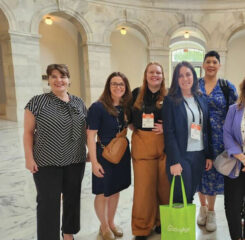Rural Housing to launch service coordination in senior, disabled communities
The COVID-19 crisis has highlighted the connection between health and housing, and the Rural Housing Service is rising to the occasion. During a call with several hundred LeadingAge members from across the country, leadership from Rural Development’s Multi-family housing programs at USDA announced efforts to bring service coordination to federally-subsidized rural housing communities.
Nancie-Ann Bodell, the Deputy Administrator for Multi-family housing programs at USDA, shared that guidance is underway to allow costs related to service coordination as part of project budgets for Section 515 Rural Rental Housing serving seniors or people with disabilities. More than two-thirds of residents in rural multifamily affordable housing are elderly or disabled; traditionally, rural housing providers have not been able to utilize program funds to pay for service coordinators at housing communities.
Modelled similar to service coordination in HUD-assisted senior housing, the program would allow owners to pair federally-subsidized housing assistance with dedicated service coordinators on site, paid for out of program budgets. Bodell said that the Rural Housing Service sees a great need for service coordination staff to work in rural communities serving low-income elderly or disabled residents, and thinks the program will be a good fit for mission-oriented housing providers within the rural multifamily portfolio. “Good owners love the service coordination program because it makes for a very healthy asset,” said Bodell on the LeadingAge call. “And I love it because it helps people and because it helps the portfolio. My experience here at RD is that we have a lot of owners who are rightly-motivated and care deeply about their communities and the folks that they’re serving.”
When asked how many properties would be able to access service coordinators, Bodell expressed concerns about limitations resulting from rent levels at rural properties. “I’m hopeful that we’ll be able to structure it with owners who are mission-centric around wanting to provide these sorts of service coordination services. I’m confident that we’ll be able to reach a good chunk of the portfolio, the cohort that serves elderly and disabled folks, which is 67%,” said Bodell. The Deputy Administrator expected the new guidance to be issued by the agency in 8-12 months.
Financial Hardship and COVID-19
On the national call with LeadingAge members, Bodell also shared a summary of the Rural Housing Service’s response to COVID-19. With the average annual income of residents hovering between $11,000 and $13,000 for Section 515 properties, rural communities supported by the agency went into the crisis with extremely low-incomes, and with that, slim margins for further income reductions.
Bodell said that since the start of the national emergency, her staff have seen a significant uptick in financial hardship among residents served by USDA-assisted projects. In particular, Rural Development’s Multi-family housing programs has seen increasing numbers of interim income recertifications, which is the mechanism tenants use to lower their monthly rent payments based on their financial situation. In most cases, interim recertifications are only completed if a resident experiences an earned income loss, which applies less to older adults who have lower rates of employment. However, the agency has received increasing requests for lowered rent payments from non-wage earners, for example due to income deductions resulting from higher medical expenses for older residents.
Because the Rural Housing Service programs operate on tight budgets approved annually by Congress, Bodell and her team have been monitoring Rental Assistance utilization closely across the rural portfolio. The agency keeps track of changes in tenant rent contributions – and the accompanying higher levels of federal rental subsidy needed to cover rent costs – as an indication of the program’s funding needs.
By monitoring the levels, the agency can anticipate any rental assistance shortfalls and report funding needs to congressional offices. Unlike HUD, Rural Housing has not received relief funds from the CARES Act or other COVID-19 relief bills. LeadingAge continues to support supplemental rental assistance funds for rural housing programs during the emergency.
Challenges and Opportunities for Rural Communities
Rural communities are uniquely positioned to respond to COVID-19, but also particularly vulnerable. The agency staff have heard of confirmed cases, but have been deferential to CDC and local guidance for managing health crises at multifamily projects. Bodell discussed creative efforts on behalf of community managers to support social distancing in management offices, laundry rooms, and other ongoing needs.
Because Rural Development is both the lender and the subsidy provider of multi-family direct loans with rental assistance attached, the agency can react more nimbly to the current crisis, according to Bodell. This has helped the agency quickly offer forbearance relief and rental assistance adjustments for the portfolio.
Employment bases in rural areas are also uniquely vulnerable to the crisis, because they are in many cases more monolithic, and therefore less dynamic, leaving rural residents with sudden and significant wage loss. Bodell also reported that only three-quarters of renters in the portfolio receive rental subsidy, meaning the remaining 100,000 renters don’t have the ability to adjust rent payments due to income loss.
Bodell also discussed the technology gaps in the rural housing portfolio: “Our biggest technology gap is…we need an automated system for processing Section 538 direct loan applications.”
A recording of the conversation between Nancie-Ann Bodell, Deputy Administrator of MFH programs with the Rural Housing Service, and Ruth Katz, Senior Vice President of Policy with LeadingAge, is available online; rural housing starts at around minute 7:00.

Most Recommended
February 29, 2024
Say Yes to Lobby Day!
April 05, 2024
Cyberattack Updates: Change Healthcare Payment Platform
April 22, 2024
 Nursing Home Staffing Ratios: LeadingAge Is On the Case
Nursing Home Staffing Ratios: LeadingAge Is On the Case
March 27, 2024
 Colleagues on the Move, March 27, 2024
Colleagues on the Move, March 27, 2024
April 12, 2024
Improving Medicare Advantage
Recently Added
April 22, 2024
CAST Safety Technology Selection Tool Updated
April 22, 2024
CAST Members in the News
April 22, 2024
Mental Health Training for HUD Service Coordinators
April 19, 2024



